Below are listed four very hardy corals, some information about their care, feeding, and behavior.
There are other corals that are relatively easy to care for, but really none so easy as these four.
They are listed by the names they are most commonly called by.
Mushrooms
These are soft corals known as corallimorphs and most commonly called mushrooms. For the most part it is difficult to see why they are called this because normally they don’t resemble their namesakes. However, as they move or stretch to get closer to the light, or around an object, they extend on a stalk that remains attached. It’s then they really look like a mushroom.
You will find a few types of mushrooms for sale
- Mushrooms: This is the common type and is generally sold simply as mushrooms. They are called discosoma but it is likely that the shop keeper won’t know them by this name. These are very affordable and extremely hardy. This is the species we really want to discuss and will go into more later. It’s important to mention the other types because the beginner will see them for sale and we need to be able to tell them apart.
- Ricordia (sometimes ricordea, and reicordea florida): found in the Caribbean. This is notably different because of the several bumps all over the surface. These are most typically green but are often found in orange and pink. They are not for beginners however because they require more intense lighting and require feeding.
- Fuzzy Mushroom (sometimes hairy mushrooms, and rhodactis): This is a very attractive species with several color morphs and is a close second for the beginner. The one thing that keeps it out of the running is that it reproduces so quickly that it can overrun a tank and also drive out other types of corals.
- Elephant Ear (not for beginners): So called because it grows very large, 8 to 18 inches across to be exact. Though it will seldom get that large in your tank, it will grow large enough to be a hazard to smaller fish, which it will envelop like a Venus flytrap and digest. This is not for beginners because it requires much space, feeding, and is known to eat crustaceans or small fish. Because of it’s special size, and the chance it will eat things in your tank, this is not considered a beginner’s mushroom.
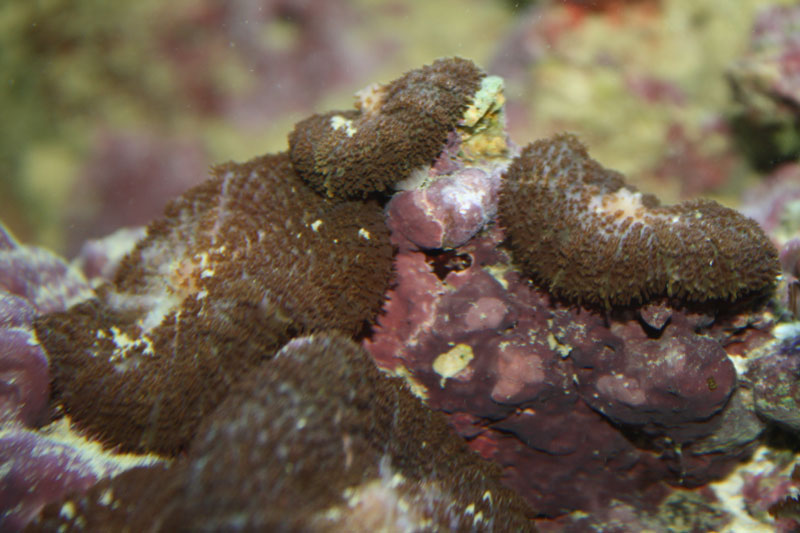 |
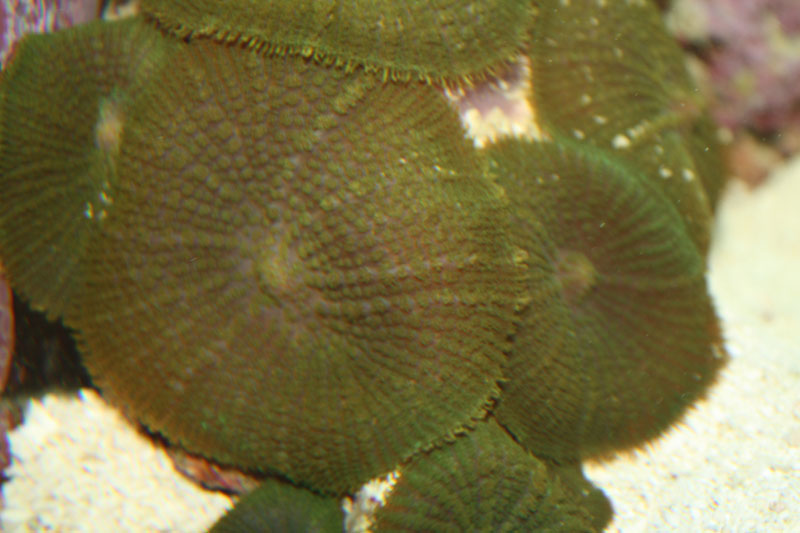 |
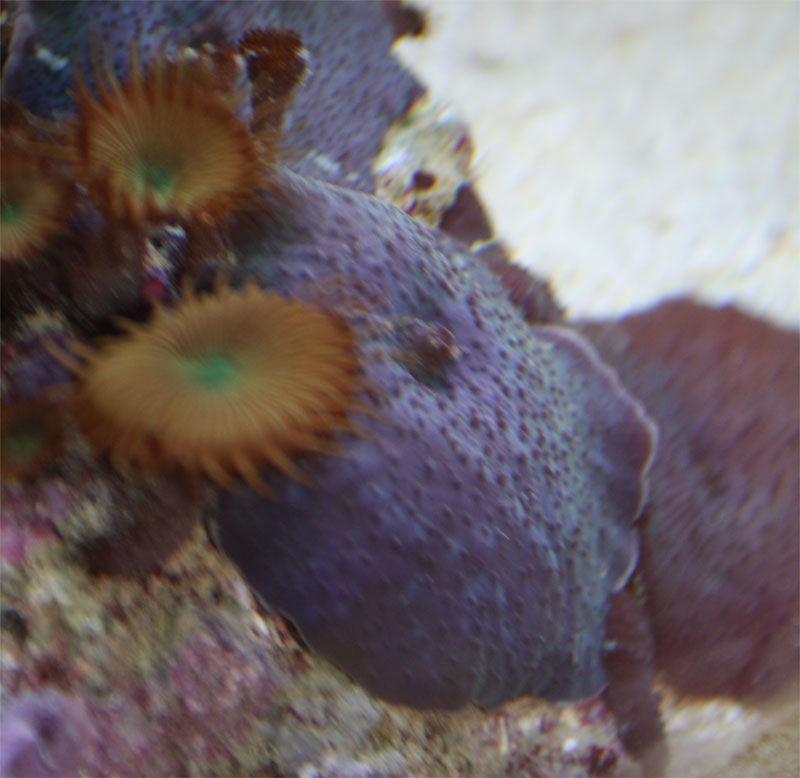 |
 |
Mushroom care
Just about nothing! Which is exactly why this coral makes the top of the list. Mushroom corals like low lightly, can be placed low in the tank, even on the substrate if necessary, and, while they can be fed, get their food from zooxanthellae. They tend not to be very aggressive and have been known to grown right up next to other corals without much of a problem other than overlap. Also, the price is right. For example, a good sized rock with several large mushrooms growing on it can be as affordable as $28 – $36. For what you get, and compared to other species, that’s a steal. They do reproduce in the tank but not so quickly as to become a nuisance.
Tip: if the light is too bright they tend to fade in color. Several colors are available, mostly green but brown, red, and even striped.
Button Polyps (paly)
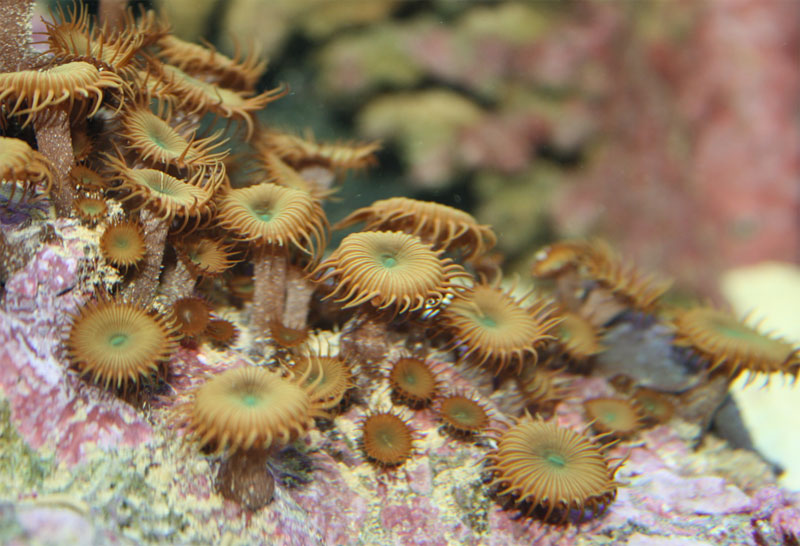 The button polyps I have in my tank were hitchhikers on a bit of live rock I purchased. There were three of them and now at least 50 of various sizes. It has taken some time to get to that number so you don’t have to worry about them over growing. They do OK in moderate light and don’t need to be fed. They really look after themselves and are quite hardy. For some the color may seem drab, but upon close inspection you will find there is a wonderful gradient of color on the heads.
The button polyps I have in my tank were hitchhikers on a bit of live rock I purchased. There were three of them and now at least 50 of various sizes. It has taken some time to get to that number so you don’t have to worry about them over growing. They do OK in moderate light and don’t need to be fed. They really look after themselves and are quite hardy. For some the color may seem drab, but upon close inspection you will find there is a wonderful gradient of color on the heads.
One of the fun things about this coral is watching their many tentacled head close up when disturbed and watch it reopen again soon after. They can survive in a tank with lower light and moderate water quality. In a well maintained environment they will grow and thrive.
Caution: These and other similar corals contain a poison called palytoxin. If you are going to touch the coral itself then wear gloves. Protect your eyes as well being sure not to rub them or get any of the toxin in them. Research this toxin on the web for detailed information and safety instructions.
These are also among the more affordable corals out there.
Pulsing Xenia
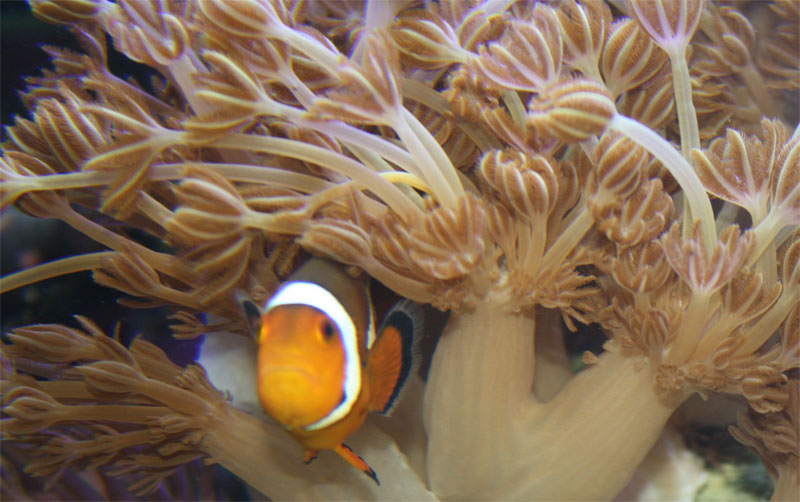 This particular species of Xenia is very fast growing and spectacular to observe. The name comes from the fact that the heads of each colonial polyp open and close quickly and rhythmical. These corals pretty much take care of themselves which is why they make the list. They like brighter light and will be at home toward the top of the tank. They can be fed, but don’t require it.
This particular species of Xenia is very fast growing and spectacular to observe. The name comes from the fact that the heads of each colonial polyp open and close quickly and rhythmical. These corals pretty much take care of themselves which is why they make the list. They like brighter light and will be at home toward the top of the tank. They can be fed, but don’t require it.
However, there are a few things the beginner should know.
- Xenia will grow like a weed! They just grow and grow. It gets to the point where some must be removed. These can be given to friends or disposed of.
- They move. As Xenia grow, they move about the tank and will occupy the space they find the best. Often moving up to higher ground to obtain more light. They make great shade trees under which to plant low light corals but can also intertwine themselves with other species. Depending on how you like your tank, this may be OK. I like to have my species in neat groups so having Xenia pop up in the middle of my mushrooms gets it removed.
- They are not aggressive and will usually loose a battle with a more aggressive coral. Not always though, gonoporia tend to become irritated.
Clown fish will use Xenia as a host! Of course, it does not provide the protection to them that a real anemone does, but they do find it a comforting place to hide. While you will always reed that clownfish don’t need an anemone, they are less stressed when they have one. However, keeping an anemone can bee tough, and is more for the advanced aquarist with more time to devote to water changes. So, Xenia gives you a host, without the hassle.
Anthelia
Anthelia is an attractive coral that is easy to keep. It tends to do well in tanks with slightly elevated nutrient levels. In my experience it tends to be more hardy than Xenia and grows quite fast as well. There are several color morphs with pink being probably the easiest to keep. You will commonly find this coral sold as “waving hand” coral.
One of the nicest things about Anthelia is that it’s affordable. If you have a friend or fellow aquarist with some, just have them pull off a few polyps for you and you have a free coral that will grow. Don’t pay too much in a LFS for this coral unless it’s a unique color like the flame Anthelia which has a bright orange stripe down the spine of each tentacle.
While Anthelia can do well with lower light, it requires a little more than Xenia. Anthelia does best with a moderate indirect flow. It can tolerate higher flow, but in my opinion doesn’t look as attractive in high flow areas of the tank.
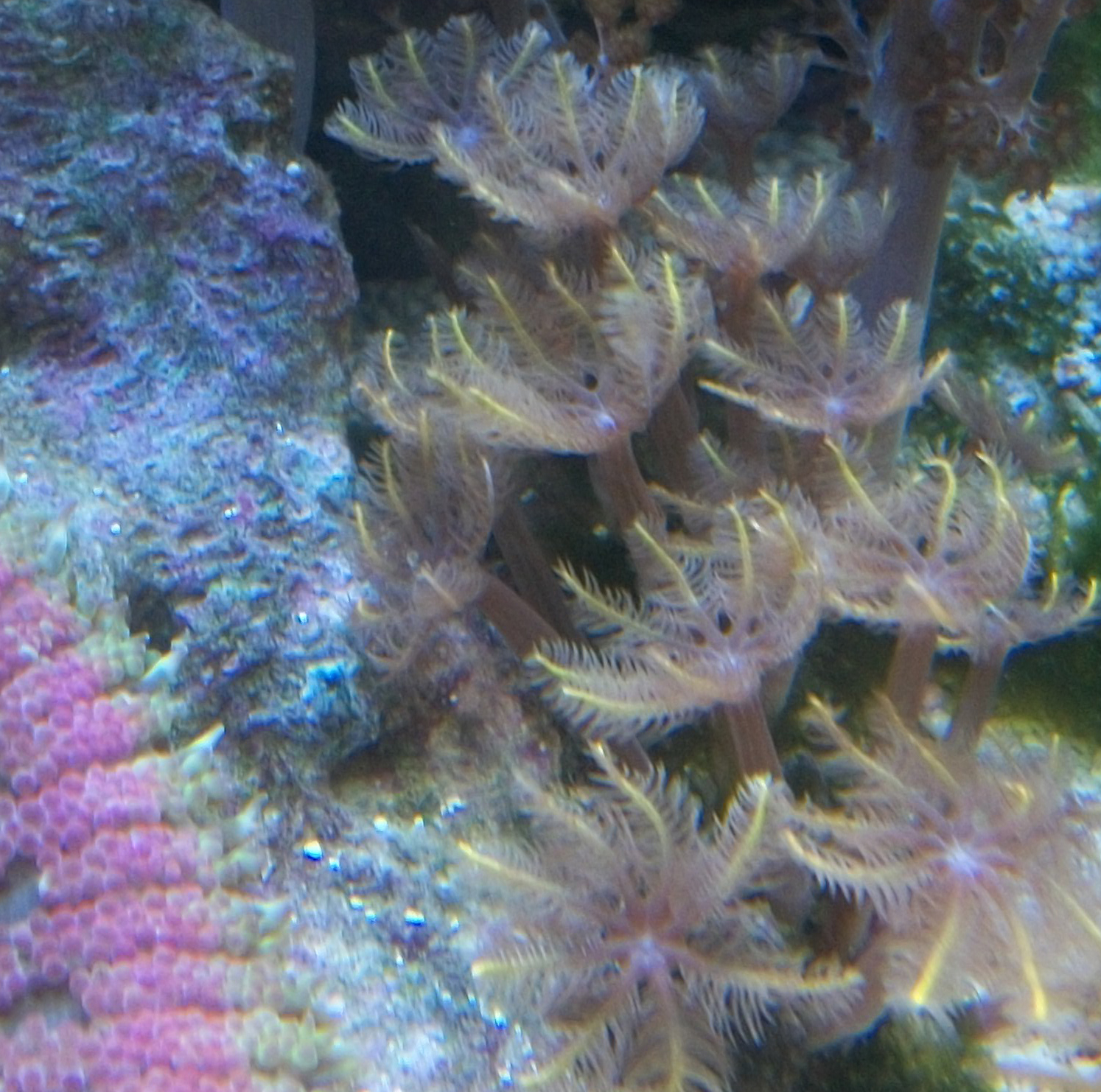 |
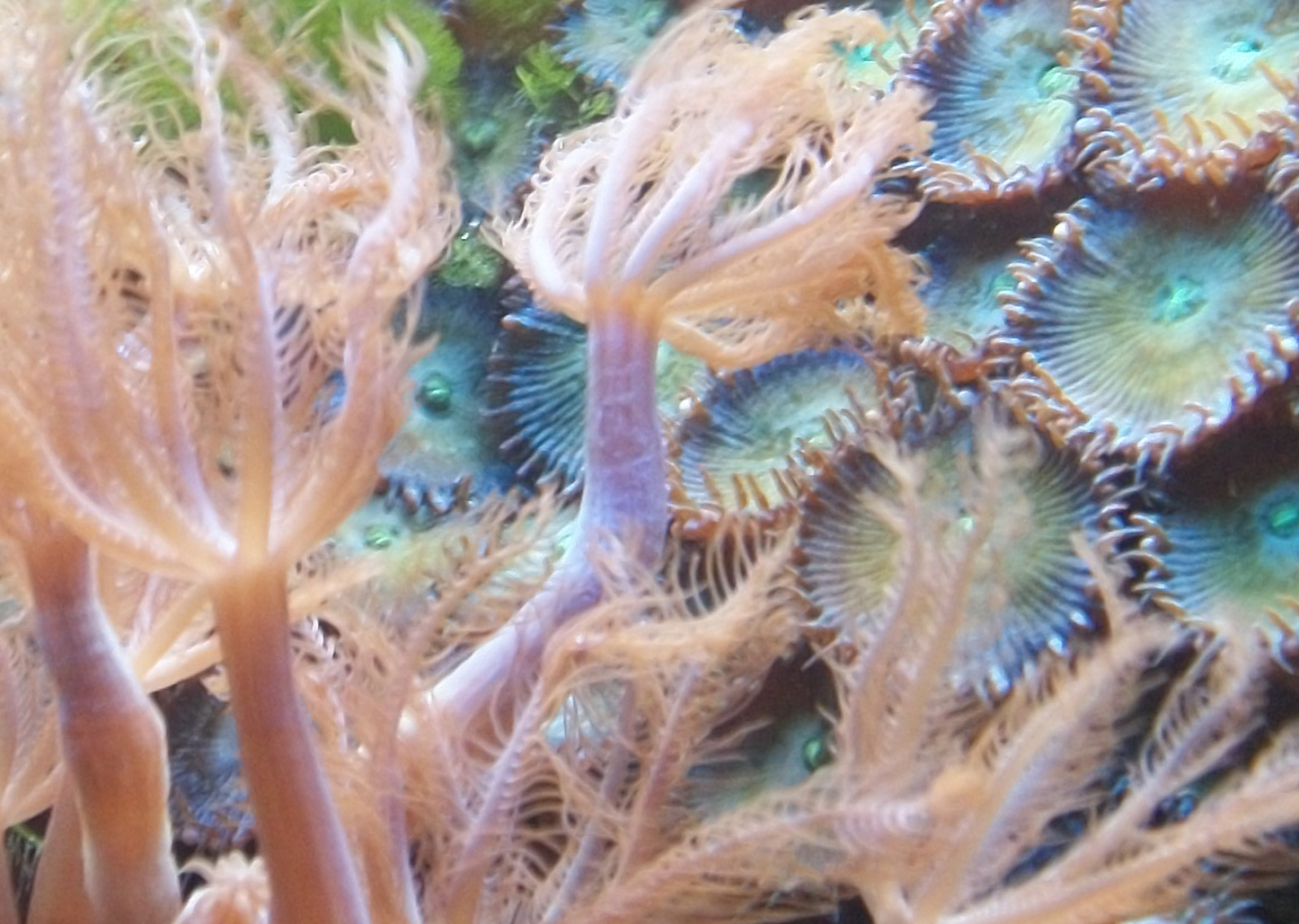 |
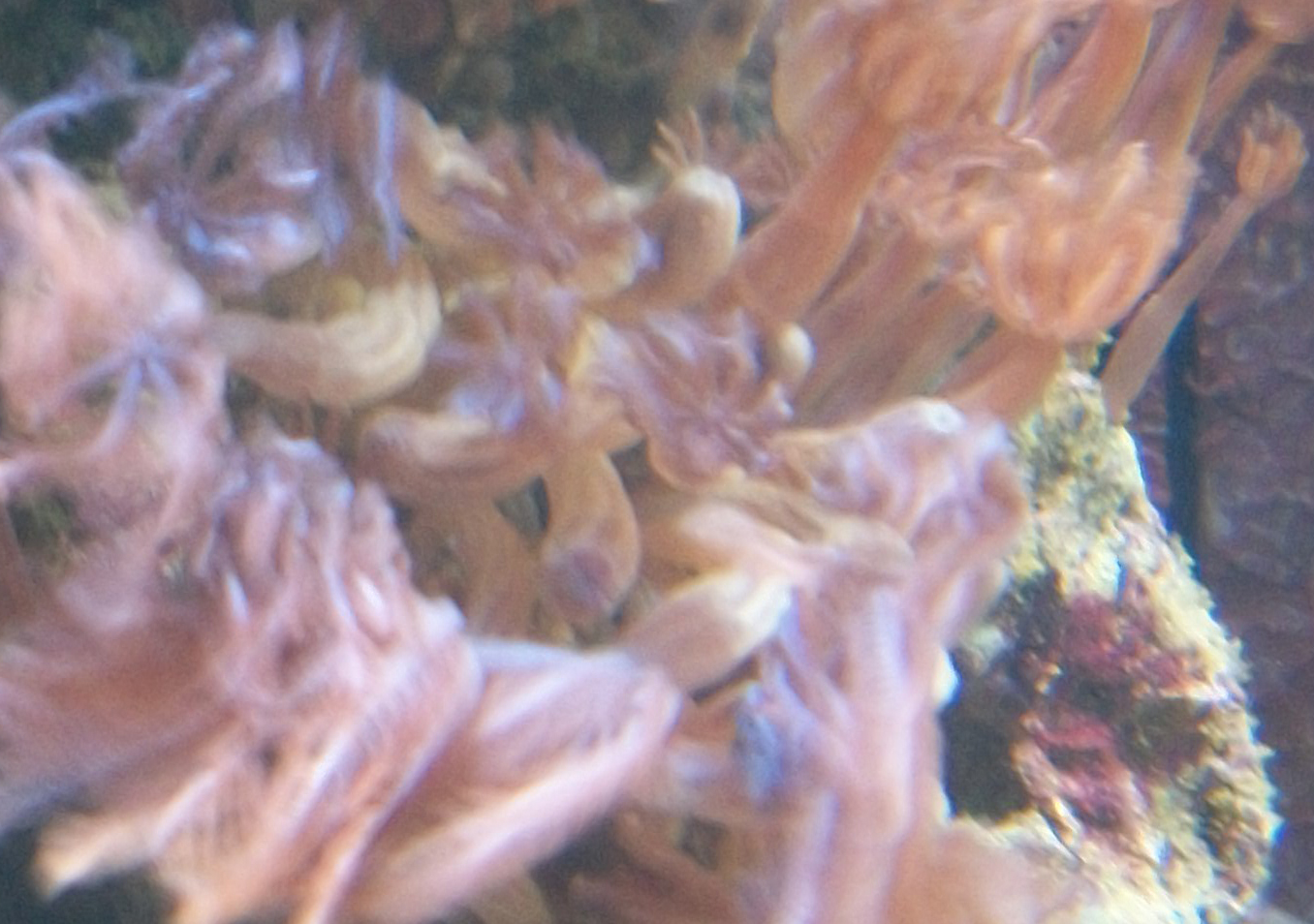 |
| Flame Anthelia | Pink Anthelia | Anthelia in high flow looking ugly |
Caution: This is a fast growing coral that can take over large areas of your tank. Not quite as fast as Xenia though. The main problem with this is that they are more difficult to remove than Xenia is. Also note that because this is a taller coral if it over grows an area where a shorter coral is it can block out the light from getting to that shorter coral.
Special thanks to Brenden (Chalkoutline on thereeftank.com) for reminding me of this great beginner coral!
What about zoanthus?
While an excellent and hardy coral there are two things that keep if from making the list.
- Slightly more expensive than the above
- Slightly more picky about water quality, lighting and tank placement.
Zoanthus should be the next coral you buy after you’ve gotten your feet wet with the above three. It comes in many color morphs, some that dazzle the eye, and doesn’t cost too much from your LFS.
What about green star polyps?
Like zoanthus this is a good hardy coral but it doesn’t make the list for a couple of reasons.
- Does not do as well in higher nutrient tanks. It tends to be like the canary in the coal mine and shrinks up first as the phosphates and nitrates rise.
- Slightly more expensive than the other four corals above. If you are just starting out, go cheap so you can save your money for the nice corals later.
- Requires more light than the other corals on the list making them less suitable for low end tanks.
If you have been keeping the corals above alive for about six months, then I would say give GSP a go. Be sure to place it where it gets plenty of light, but not too much, and a good amount of flow. It tends to like higher flow but not directly on it.
Conclusion
There you have it! Four corals for the beginner which are affordable and will grow happily in your tank. There are other corals you could try, but the success rate with these will be higher. Money is also a factor. No one wants to experiment with a $60 coral that might just die. Practice your skills with these, then move up to something more difficult.
